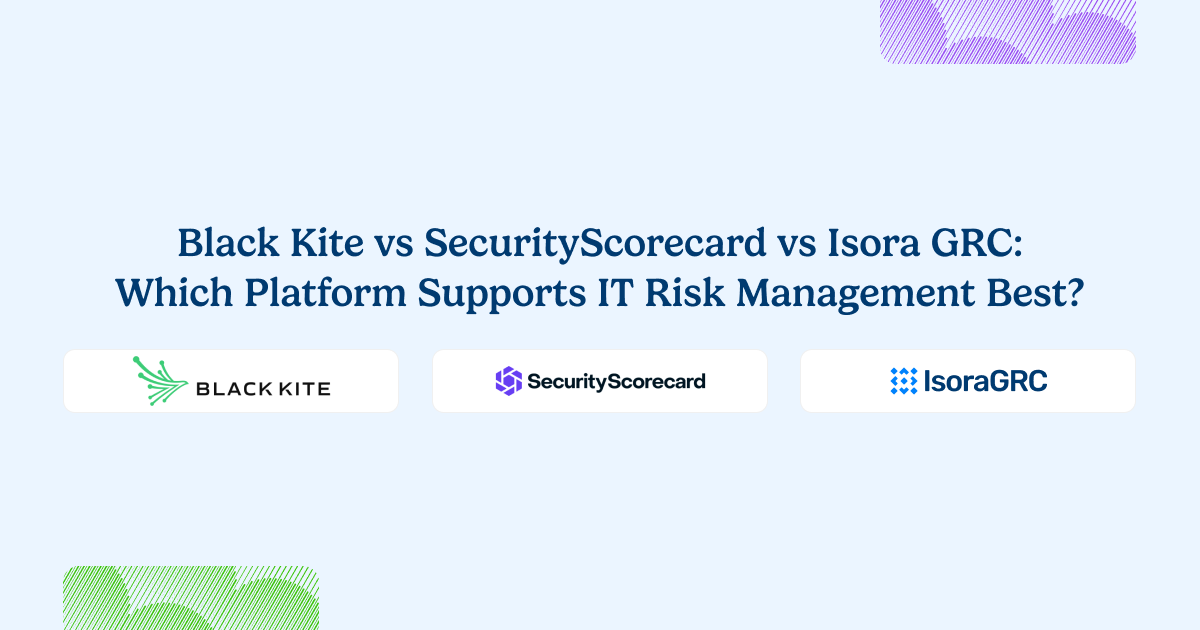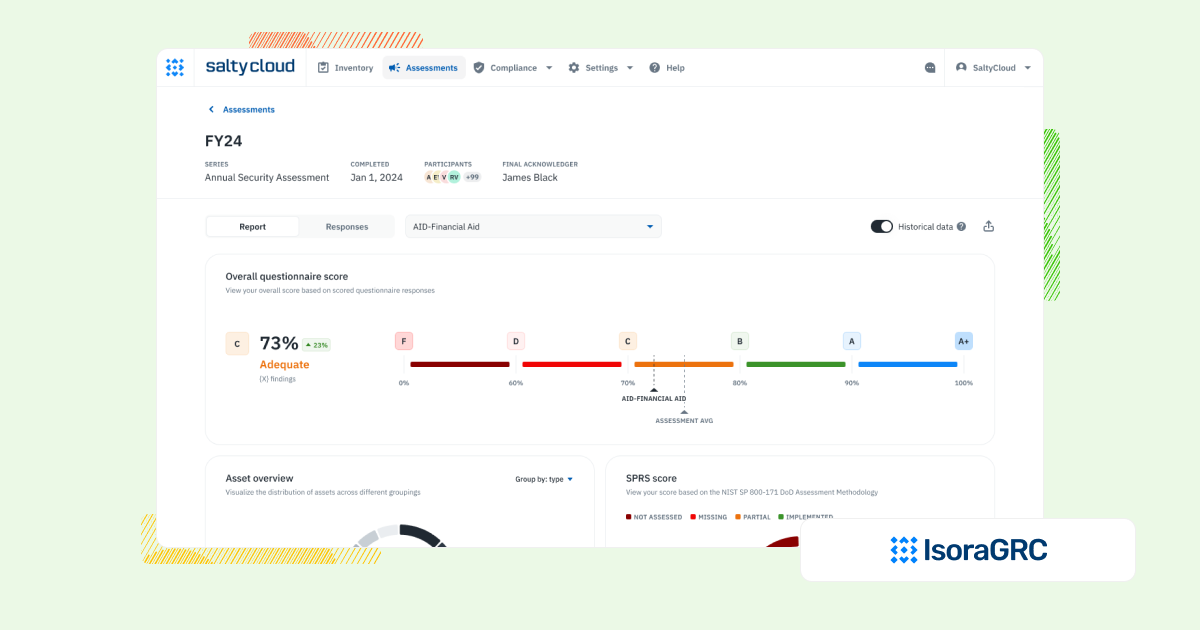
Every security team needs a practical, scalable way to manage IT risk—not just monitor external vendor ratings.
Platforms like Black Kite and SecurityScorecard focus on vendor intelligence, providing external scores to identify potential risks in third-party relationships.
External scores can highlight issues, but they don’t help you assess, track, or resolve risks in a structured and actionable way.
Isora GRC takes a different approach. It’s purpose-built for security teams who need to run assessments, manage inventories, and track risks—moving beyond just vendor scores to comprehensive risk management.
Let’s take a closer look.
Choosing the Right Platform for IT Risk Management
Black Kite and SecurityScorecard provide outside-in vendor insights. They’re great for scanning for vulnerabilities or leaked data—but they don’t reflect how vendors are actually managing their internal security programs. There’s no support for customized assessments, risk remediation, or reporting that reflects business context.
Isora GRC lets security teams assess what matters. You can use structured questionnaires, collect supporting documentation, review findings, track exceptions, and maintain a shared understanding of vendor risk across your organization. Whether you use NIST, HECVAT, or your own framework, Isora adapts to your workflow—not the other way around.
The Workflow That Matters: Managing IT Risks and Compliance
Vendor intelligence tools give you visibility. But risk management demands action. Teams need to move from identifying potential risk to verifying controls, documenting gaps, and collaborating with vendors to resolve them.
Isora GRC supports every step. It allows for ongoing assessments, links vendors to business units, tracks decisions, and ties outcomes to the risk register. It’s a complete, auditable workflow—ready for both internal oversight and external audits.
How Each Platform Supports IT Risk Management Workflows
| Workflow Area | Black Kite | SecurityScorecard | Isora GRC |
| Assessment Management | Black Kite checks vendor risks using ratings. Some users say the setup doesn’t always match team workflows and needs extra setup. | SecurityScorecard focuses on rating and checking outside companies for security risks. This helps with vendor risk but doesn’t go deep enough for full internal assessments. Teams needing risk checks across many departments might want more control and flexibility. | Centralized, intuitive assessment dashboard across business units, vendors, and assets. Built specifically for security teams. |
| Questionnaire Delivery & Completion | Black Kite leans on automatic checks. It may not support strong survey tools. Teams needing many detailed surveys may feel restricted. | SecurityScorecard doesn’t focus on sending surveys or forms. It mainly runs automatic checks on third-party risks. This may not work well for teams needing custom surveys or forms for internal use. | Customizable and prebuilt questionnaires for frameworks like NIST, ISO, GLBA, HIPAA, and more. Designed for internal and external collaboration. |
| Inventory Tracking | Black Kite focuses on third-party risk. Full inventory tools aren’t included. Companies with big internal systems might need other tools. | SecurityScorecard skips full inventory tools. It works mostly on security ratings for outside vendors. Companies with large internal systems or many assets might find this missing feature a problem. | Centralized tracking of assets, vendors, and organizational units with integration support for existing data sources. |
| Risk Register & Exception Management | Black Kite helps track risks but lacks full tools for risk registers and exceptions. Teams needing deeper internal tracking may find limits. | SecurityScorecard gives insight into third-party risks but lacks full risk register tools and detailed exception handling. Companies needing full internal tracking for risks and exceptions might feel limited. | Flexible, collaborative risk register with scoring, status, evidence, and ownership tied directly to assessments. Exception management is built-in and intuitive—no extra modules or configuration required. |
| Scoring, Reporting & Risk Visualization | Black Kite offers ratings and insights. But advanced charts and reporting tools may feel too simple for some users. | SecurityScorecard does well with external security ratings and reports. But those needing deep reports and charts for internal risks might find the platform too narrow. Reports focus on outside risks, not full internal tracking. | Automated scorecards, risk maps, and executive-friendly reports with actionable insights—no manual config required. |
| Collaboration & User Experience | The design focuses on security checks. Some say the way it works feels confusing at first and takes time to learn. | The design is clean and works well for security teams checking outside risks. But tools for teamwork may feel weak compared to platforms built for broader tasks. Internal risk teams might miss features for better group work. | WCAG-compliant, award-nominated interface with built-in commenting, team workflows, and fast onboarding. |
| Implementation & Setup | Setup is quick for teams focused on security ratings. But for GRC needs beyond that, the platform may fall short. | Setup is simple for companies focused on vendor risks. But those needing a full GRC system for internal work may need extra tools. The system fits outside risk checks best, with limited links to internal processes. | No-code setup in days or weeks. Minimal IT lift required. Designed to go live quickly across teams and vendors. |
What Sets Isora GRC Apart?

Isora GRC was purpose-built for information security teams—designed to support the real workflows behind risk and compliance, not just generate reports. While legacy GRC platforms require months of configuration and rigid processes, Isora takes a modern, scalable approach:
- Purpose-built for security and third-party risk teams
- No extra modules or cross-department bloat—just the workflows that matter.
- Easy for anyone to use
- Clean UI, no complex training, and built to drive adoption across the org.
- Streamlined for action, not just documentation
- Assessments, questionnaires, inventories, risk tracking, and reporting—all in one place.
- Fast, no-code implementation
- Go live in weeks, not quarters, with minimal IT lift.
- Scales with your program
- Whether you’re running a lean risk function or supporting a large institution, Isora grows with you—without getting in the way.
Who Each Platform Is Best For
| Platform | Who It’s For |
| Black Kite | Translating vendor risk into business terms. More of a lens, not a control system. |
| SecurityScorecard | Seeing how vendors stack up at a glance. Doesn’t help much with full program management. |
| Isora GRC | Security teams that need a scalable, usable IT risk management program across their organization. |
What Our Customers Say About Isora GRC
Security teams at top institutions are using Isora GRC to replace legacy tools and manual processes with intuitive workflows and actionable insight.
“Moving from manual processes to using Isora was a breath of fresh air. What used to take months is now automated, reliable, and defensible. Isora saves us significant time while delivering accurate insights that improve decision-making.”
Jessica Sandy, IT GRC Manager, The University of Chicago
“Isora has been essential in helping us meet our University of California cybersecurity requirements across a decentralized campus. Automating assessment data collection and reporting has given us clear visibility into unit-level risks, enabling us to prioritize resources effectively and address gaps with confidence.”
Allison Henry, CISO, The University of California, Berkeley
FAQs
What’s the difference between Black Kite, SecurityScorecard, and Isora GRC?
Black Kite and SecurityScorecard provide external risk ratings based on publicly available data about vendors. Isora GRC enables full third-party risk workflows—issuing questionnaires, managing vendor inventories, tracking exceptions, and maintaining a risk register to actively manage risk, not just observe it.
Are Black Kite and SecurityScorecard considered vendor risk management platforms?
They offer vendor intelligence, not full vendor risk management. These tools highlight potential risks based on external scanning but don’t support direct vendor assessments, internal reviews, or remediation tracking.
Does Isora GRC replace platforms like Black Kite or SecurityScorecard?
Yes, for teams looking to manage—not just monitor—vendor risk. Isora GRC provides tools for assessing vendors using frameworks like HECVAT or SIG, collecting evidence, resolving exceptions, and maintaining a collaborative risk program.
Which platform is better for managing third-party risk across the organization?
Isora GRC is designed for hands-on vendor risk management. While Black Kite and SecurityScorecard provide visibility into external posture, Isora supports the structured workflows needed to evaluate, respond to, and track third-party risks across business units.
Can Isora GRC be used alongside Black Kite or SecurityScorecard?
Yes. Some organizations use these tools for external monitoring and complement them with Isora GRC to run internal reviews, send questionnaires, and track vendor remediation efforts.
What should I look for in a vendor risk platform that goes beyond vendor risk scores?
Look for the ability to run assessments, collect documentation, engage vendors directly, and track exceptions in real time. Isora GRC provides all of this in a platform that enables true vendor risk management—not just risk scoring.


















